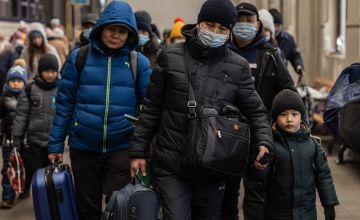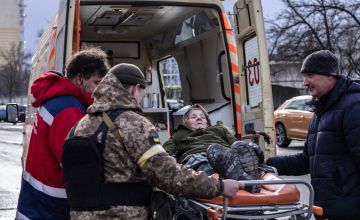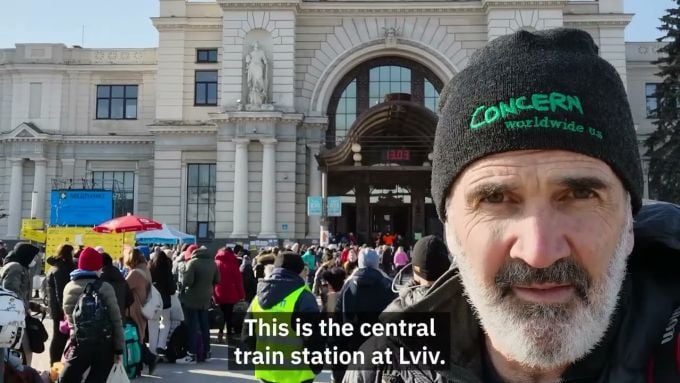
Knowledge Hub
The Ukraine crisis, explained: 6 things you should know

On February 24, 2022, a long-simmering crisis in Ukraine escalated into conflict and violence with devastating impact. Two months later, nearly 30% of the country’s population is displaced, and another 30% are stranded in conflict zones. Here’s what you need to know about the Ukraine crisis from a humanitarian perspective.
The Ukraine crisis, by the numbers
As of April 29, 2022:
- 5.3 million refugees
- 7.7 million internally displaced people (IDPs)
- 13 million civilians stranded in combat zones and unable to leave
- 15.7 million people in need of humanitarian aid
- 6,009 confirmed civilian casualties
- 2,829 confirmed civilian deaths
1. Ukraine is now the world’s second-largest refugee crisis
From a humanitarian perspective, the Ukraine crisis is largely a refugee crisis. In just the first week of hostilities, over 1 million Ukrainians fled home, often with little more than a few days’ worth of clothes and food. As of April 29, that number is now at 5.3 million refugees, swiftly making Ukraine one of world’s largest refugee crises (second only to Syria).
Additionally, 7.7 million Ukrainians are displaced internally within their own country. In total, the conflict has uprooted 13 million Ukrainians, approximately 30% of the country’s population. The UNHCR also estimates that 13 million Ukrainians are stranded in zones of conflict and are unable to leave due to heightened security risks, destruction of bridges and roads, and/or a lack of information on where to find safe accommodation.
Poland has taken in nearly 3 million Ukrainian refugees, many of whom had friends and family living in the country before this recent escalation in conflict. (1.5 million Ukrainians lived in Poland at the beginning of 2022.) This represents a huge increase: In Kraków alone, the city’s population increased by over 20%. In March, the Polish government passed a law allowing Ukrainians to legally live and work in the country for 18 months, with an option to extend.
2. Many refugees from Ukraine were previously refugees from other countries
At the end of 2021, Ukraine was host to over 4,000 refugees and asylum-seekers, including people from Afghanistan, Syria, Somalia, Bangladesh, Pakistan, and Iraq. The UNHCR had also registered over 35,000 stateless persons in the country, and over 730,000 internally-displaced Ukrainians (owing to earlier years of conflict). There are also many foreign-born students doing their degrees in Ukraine, many of whom face credible danger should they return to their home country.
The initial broad reach of conflict within the country — which saw at least 10 of the country’s 27 regions or oblast under attack — has shrunk to focus on the eastern region. However, the initial weeks of widespread violence meant that many people had to move more than once to reach safety. As reports at the border confirmed, non-Ukrainian nationals also faced greater difficulties in crossing to safety compared to Ukrainian citizens.
Beyond the vulnerabilities caused by these logistics, refugees who fled conflict in their homeland only to be met with more conflict in their host community may face re-traumatization both due to the violence and the resulting displacement. It’s important that the unique needs of those who have been forced to migrate at least once before are taken into consideration.
3. What happened in February of 2022 wasn’t the start of the conflict—or the crisis
A quick timeline from last month may be useful here: On February 21, 2022, the Russian Federation officially recognized the independence of two non-government-controlled areas in eastern Ukraine, Donetsk and Luhansk. Two days later, Ukraine declared a nationwide state of emergency. On February 24, the Russian Federation announced a military operation on Ukraine.
However, none of these actions happened in a vacuum. An armed conflict in eastern Ukraine began in Crimea nearly eight years ago to the day following the February 21 recognition. As we mentioned above, nearly three-quarters of a million Ukrainians are internally displaced, largely due to the last eight years of instability. Those living in the Donetsk and Luhansk regions—approximately 3.4 million, including 510,000 children—have faced nearly a decade of insecurity, compounded by the Covid-19 pandemic (to say nothing of a recent polio outbreak in western Ukraine).
Despite nearly a decade of conflict in eastern Ukraine, most Ukrainians — and other European nationals in the surrounding area — told the press that they never imagined a full-scale military operation would take place. While many began formulating their own emergency plans earlier in February, few believed they would need to act on them. City resources, like neighbourhood bunkers and bomb shelters, were shared, but they were locked and residents were unclear as to who was responsible for opening them in case of an attack. As one Kyiv local put it, 'we know where we need to go, but we don’t know if that’s really going to help.'

4. Those still in Ukraine are suffering
Violence has only escalated in the weeks following February 24, with intense fighting reaching the Ukrainian capital of Kyiv. By now, we’ve all seen the photos of the destruction that’s followed in the wake of conflict, including in theatres and maternity hospitals. As of April 29, the UN has recorded 6,009 civilian casualties and 2,829 civilian deaths.
In cities like Kyiv, Kharkiv, and Odesa, residents have taken to sheltering and sleeping in underground subway stations. Hundreds of thousands have lost electricity and water at home due to the major damage inflicted on civilian infrastructure. The WHO reports that Ukrainians with chronic diseases (such as cardiovascular disease, diabetes or cancer) are especially vulnerable: One-third of families in which at least one member has a chronic health condition are currently unable to get the medications and treatments they need. As healthcare facilities remain targets for attacks, many Ukrainians opt to stay home. Expectant mothers and women who have recently given birth also face health risks for the same reason.
5. While this is primarily a refugee crisis, it could also become a hunger crisis
A leading agricultural exporter, Ukraine has (together with Russia) been described as ‘the breadbasket of Europe.’ According to the Famine Early Warning Systems Network, crop production in the country could decrease by as much as 50% this year due to halted planting seasons, crop and land losses, and fuel and fertiliser shortages.
This means escalating food prices and massive food shortages, the ripple effects of which will be felt in countries that depend significantly on Ukraine and Russia for staple grains, oil, and seed imports. Ultimately, people living in extreme poverty will bear the brunt of this. At the start of 2021, around 45 million people were at risk of catastrophic hunger. Concern and Welthungerhilfe’s Global Hunger Index for that year highlighted how protracted and violent conflict is driving global increases in hunger and malnutrition (alongside climate change – and exacerbated by the Covid-19 pandemic).
6. This is not going to be a short crisis or a quick recovery

Many experts close to the situation, from both a political and humanitarian perspective, agree that there will not be a short road to peace. If violence spreads or intensifies, this will continue to carry the harshest impact for Ukrainian civilians, both those who remain in their country and those who seek asylum abroad. Displacement numbers will also continue to rise if this is the case, which could overwhelm neighbouring countries — most of which are smaller than Ukraine and not prepared for an influx of indefinite displacement. Additional support may be needed in this case.
Even after treaties are signed and troops withdraw, recovery efforts will likewise not be easy or short-term. Violence has already destroyed communications towers, schools, residential neighbourhoods, water points, hospitals, and roads. Returning refugees who have lost everything will need help to rebuild their lives, homes, and communities without facing cyclical poverty. Millions will need psychosocial support and protection, both now and when this crisis concludes. Women and children — who make up most of Ukraine’s refugees — face added vulnerabilities, along with people who are disabled, the elderly, and ethnic minorities (citizens or not).
Despite an outpouring of funding, UNOCHA reports it’s only 44% of what’s needed for the interventions necessary to keep the Ukraine crisis from further deepening. An initial three-month plan was revised to six months, covering support through August 31, 2022. A long-term plan complements this, covering humanitarian response in Ukraine and its surrounding countries through the end of the year. Together, both plans require a combined €4 billion to ensure that the UN and partners — including Concern — can support those Ukrainians who need it most. UNOCHA notes this is an increase of funding need of over 140% since initial estimates in late February.
Concern in Ukraine: What we're doing
Concern initially deployed a small emergency response team to Krakow, Poland, working in tandem with local organisations, our Alliance2015 partners, and the UN. On the border between Ukraine and Moldova, Concern’s humanitarian partners are providing hot meals, hygiene materials, SIM cards, psychosocial information support, and transportation to people fleeing the violence.
Having conducted initial assessments on the borders with Poland, Moldova, Hungary, Slovakia, and Romania, Concern’s focus is now turning to inside Ukraine, where we feel the needs are greatest. We are partnering with Czech organisation People in Need and French organisation ACTED to scale up the delivery of life-saving humanitarian aid both within Ukraine and at the borders.
This includes:
- Delivering food, hygiene items, trauma kits, nappies, sleeping bags, and mats into Ukraine to the cities of Lviv and Kyiv by truck and train.
- Providing essential supplies and support to internally-displaced families in Ukraine; access to clean water; psychosocial support for those traumatised by conflict and displacement through a telephone hotline.
- Supporting Ukrainian people at border crossings by providing food to children on the roads leading to the border with Poland, assisting with building toilets and heated tents, and providing hygiene supplies such as toothbrushes, toothpaste, shower gel, shampoo, and sanitary products.
The humanitarian crisis in Ukraine: How you can help
‘Humanitarian needs are escalating as hundreds of thousands seek safety across borders. With the support of the public, we are there to help those in need,’ says Concern Worldwide CEO Dominic MacSorley said. ‘We urge you to support our appeal for funding in any way you can.’
Concern’s Emergency Fund is 100% designated to fund emergencies, including the crisis in Ukraine, and can be deployed rapidly when days or even hours make all the difference.
With your help we can respond and help families affected by the conflict through this crisis. There is no time to waste.
Other ways to help
Donate now
Give a one-off, or a monthly, donation today.
Join an event
From mountain trekking to marathon running, join us for one of our many exciting outdoor events!
Buy a gift
With an extensive range of alternative gifts, we have something to suit everybody.
Leave a gift in your will
Leave the world a better place with a life-changing legacy.
Become a corporate supporter
We partner with a range of organisations that share our passion and the results have been fantastic.
Create your own fundraising event
Raise money for Concern by organising your own charity fundraising event.







